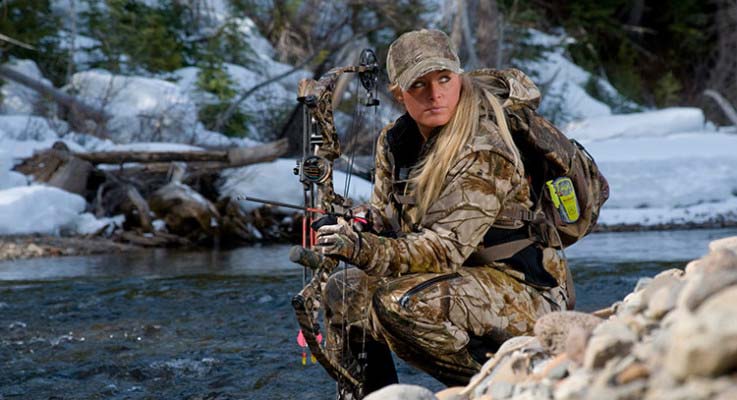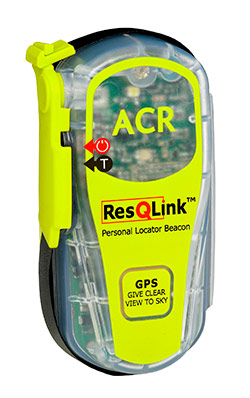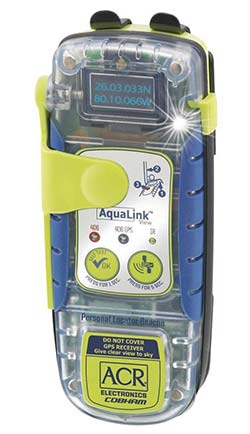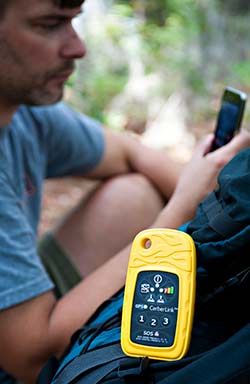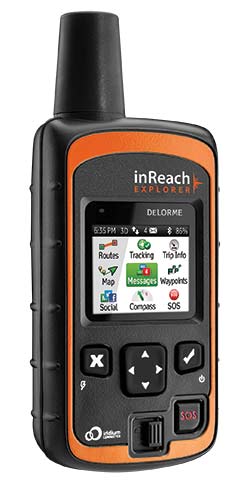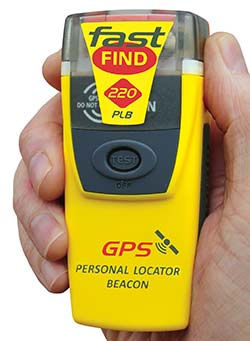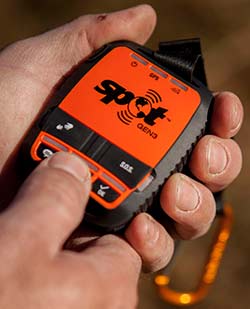With their boat sinking some 12 miles off the coast of Hawaii, a group of adults and children made the news last August after the rescue was video recorded by one of the kids. But what was largely glossed over by those in the mainstream media was that they used an emergency radio beacon to ensure their survival. Without it, the tale may have had a grim ending.
Venturing into the wilderness or onto the water always comes with a risk of disaster. A weather event, freak accident or even criminal attack can turn a pleasurable adventure into a life-threatening nightmare. Outside the safety of more populated areas, calling 911 is simply not an option. When danger strikes away from civilization, having a distress beacon can mean the difference between a bad day and your last one.
Distress Radio Beacons
Many who spend time in the outdoors consider personal locator beacons mandatory safety devices. Whether on a long wilderness hike or fishing in the Gulf of Mexico, being able to summon assistance in a crisis is critical to survival.
These rescue beacons are called by several different names:
- distress radio beacons
- emergency beacons
- PLB or personal locator beacon
- ELT or emergency locator transmitter
- EPIRB or emergency position-indicating radio beacon
- or something similar
When activated, a rescue beacon transmits a signal that can be detected by satellites. The signal information is then relayed to a center that coordinates a search and rescue response.
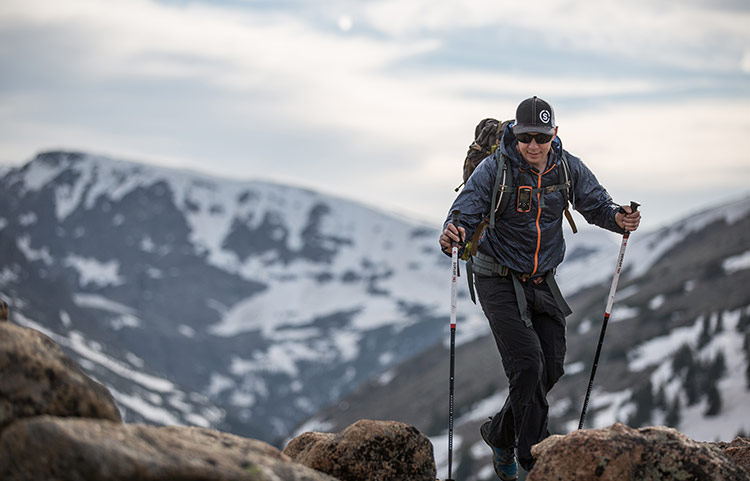
Depending on the technology used in the survival beacon, positioning of satellites and the location of the emergency, it could take several minutes to a couple of hours for a satellite to receive the distress signal and forward it to an emergency search and rescue center. Typically, systems are able to relay the information in just a few minutes .
Once the information has been forwarded to the emergency responders, it is still likely to take several hours, at a minimum, to get help to you. So, like any other emergency situation, you have to play an active role in your own survival.
Kinds of Beacons
Some locator beacons only provide an automated emergency signal, while others incorporate other functions that enhance the user’s general capabilities in the outdoors. When buying a distress beacon, carefully consider your needs and find the unit that will best serve you.
Hunters, for example, are likely to need a different tool than a boater. Also, you should check to ensure the device you are looking to buy will work in the areas you are planning on exploring. Most will work in most places. However, some will not work in extreme environments or in specific areas of the globe.
The following are some of the emergency beacons to consider.
ACR PLB-375 ResQLink+
ACR Electronics makes a number of waterproof PLB devices that are great for anyone spending time on the water. However, these devices can serve others as well including hunters, hikers and campers.
The PLB-375 ResQLink+ is lightweight – less than 6 ounces – and smaller than many smartphones. The unit is a solid choice for anyone outdoors, as the unit is both waterproof and buoyant. Wether you are kayaking into a remote hunting spot or sport fishing off the coast of Costa Rica, this can be a huge benefit.
Deployment and activation is easy – release the antenna and press a single button. The unit will instantly begin transmitting your distress call and location to rescuers. A built-in strobe light helps SAR teams find you during a nighttime search.
According to the company, rescuers are typically notified within 5 minutes of any activation in the continental United States.
The unit uses batteries that are not intended to be user replaceable. Once activated, the batteries will power the unit for 30 continuous hours, which should be more than enough in the vast majority of North American rescue situations.
There are no subscription fees or other costs associated with this unit. The company also has a free replacement policy: should you ever need to use it, they will add your used unit to their “wall of fame” and send you a new one.
ACR PLB-350c AquaLink View
The ACR PLB-350c AquaLink View is similar in operation and simplicity to the ResQLink+, but with the added feature of having a digital display so you can see all of the beacon’s activities. The display will show the GPS coordinates, battery life and when transmission bursts are made. It will even give the user suggestions on use for sending the best signal.
As with the ResQLink+, use is extremely simple: deploy the antenna and hit the call button. Even if you lose consciousness, the unit will continue to transmit and guide rescuers into your location. This unit also has a strobe light to help rescuers.
Typical battery performance is 30 hours of continuous use. Should you ever need to use it, the company will replace it free of charge. Please note that the PLB-350c is also referred to as the model 2884. Both model numbers refer to the exact same product.
BriarTek Cerberus
The BriarTek Cerberus is not a rescue beacon, but it does offer some rescue features that are worth mentioning. Essentially, the system is a two-way interface for an iPhone that allows you to send and receive short text messages.
Additionally, the system has a GPS tracker than can record your location at set intervals. These automated “check-ins” can be viewed by a friend or family member to track your progress and project your current location.
The Cerberus unit has a keypad with a distress button. As I understand the company’s literature, this distress button notifies the company’s own monitoring center, and not the international search and rescue system that is activated by a true rescue beacon.
In a non-emergency, the ability to send and receive text messages via satellite is a convenience. In an emergency, you can give rescuers detailed information about your situation and location. Additionally, the system can alert you to any dangerous weather conditions, geo-political events or other hazards that appear in your area.
The units do require a subscription plan in addition to the up front unit cost. I see these units as being a supplement to a true EPIRB.
DeLorme inReach SE & Explorer
Bundling a wealth of features into a single device, the DeLorme inReach SE & Explorer devices combine emergency rescue assistance with navigation and personal communications. Since the DeLorme offers significantly more capabilities than a plain EPIRB, it uses the respected Iridium satellite network that is said to provide 100% global coverage without any blackout areas.
When the emergency function is activated, the inReach Explorer automatically enables remote tracking and allows the user to communicate with the search and rescue center through text messages. This two-way communication allows you to provide details of your emergency and any special information rescuers may need to know. It also allows the communications center to keep you updated as to the progress of the rescue team.
Beyond its emergency capabilities, the inReach Explorer can help you navigate the backcountry with topographical maps, NOAA charts and GPS. Users can also send text messages to cell phones or e-mail addresses from the device, or when paired with your own smartphone.
The SE model provides all of the above features, while the Explorer model adds more. Included with the Explorer model are route planning and sharing, waypoint creation, trip statistics, detailed tracking, a digital compass, altimeter and accelerometer.
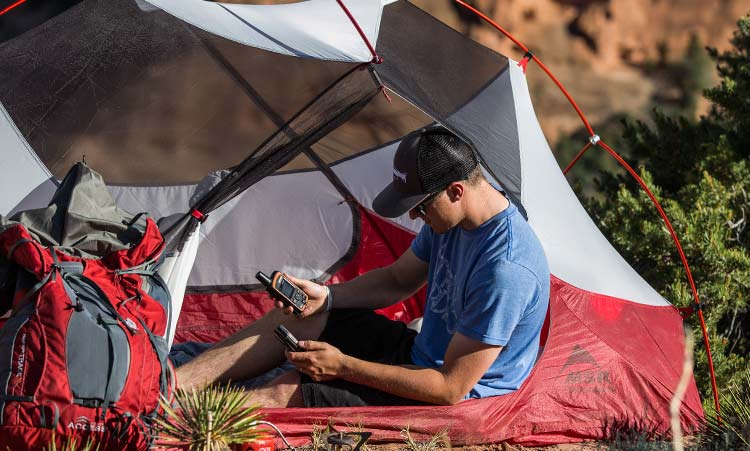
DeLorme requires a subscription to use the features of the inReach. However, the subscription can be a month-to-month subscription and canceled/restarted at any time. This works out well for seasonal users such as hunters. Discounts are given for annual subscribers, but the monthly rates are still reasonable for the services received.
McMurdo FAST FIND 220
A lightweight, handheld unit, the McMurdo FAST FIND 220 is a waterproof rescue beacon that can be used on land or at sea. An antenna is securely stored to prevent damage when handled, but deploys quickly when activated.
The FAST FIND 220 comes with a buoyancy pouch that can keep the device afloat. The unit is waterbroof to a depth of 10 meters. A bright LED emits an SOS signal that can also help rescuers locate you in dark conditions.
As with other EPIRB devices, the unit does not require any subscription or other ongoing contracts. However, it also does not have any features beyond the one-way request for help.
SPOT Gen3
Similar to the BriarTek Cerberus above, the SPOT Gen3 adds custom messaging and GPS tracking features to the fundamental ability to call for assistance in an emergency. Rescue assistance can be summoned through the use of an easily accessible button. A second button can be used to summon non-emergency assistance.
In conjunction with Google Maps, the SPOT Gen3 will regularly update your location so that family members can track your progress. This feature allows you to send a pre-programmed text message along with your GPS coordinates that populate on a Google map. This is handy to keep people updated of where you are when you are out of cell range.
The SPOT Gen3 does require a subscription service beyond the initial cost of the device to use its features. The pricing varies depending on what options are selected. The company even offers search and rescue insurance to help cover the cost of your rescue.
Bottom Line
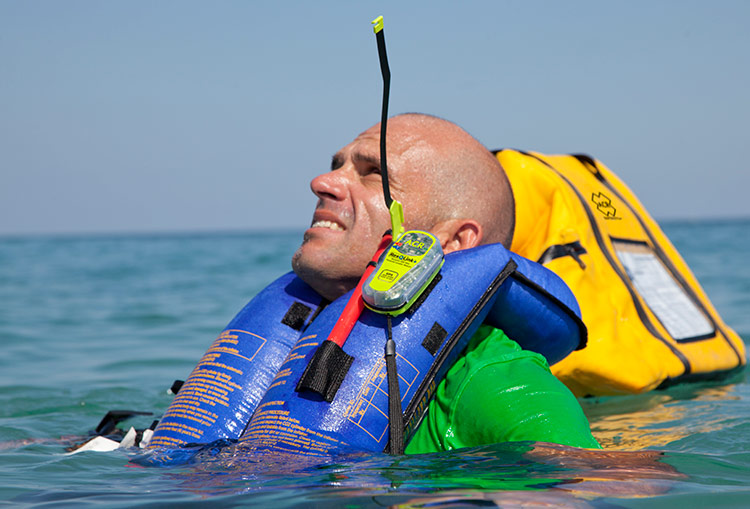
Essentially, there are two ways you can go when picking a rescue beacon: simple or feature-filled. For a simple life line, I like the ARC PLB-375 ResQLink+. It is a straightforward device that is easy to operate and can be used on land or sea without any problems. It is a one-time cost without any subscription fees, and uses a respected satellite network that will get your call for help delivered.
For a more advanced unit that will be used mostly on land, I like the DeLorme inReach Explorer. It uses the reliable Iridium satellite network for 100% global coverage but adds a wealth of features including two-way communication with rescuers, maps and pairing with an iPhone. It does require a subscription, but not a contract – so you can activate it for one month and then cut it off.
If you are looking for other cool survival gear, may I suggest reading my article here?
Last Update: October 19, 2022
Disclosure
GunsHolstersAndGear.com is an independent, for-profit website. I do not charge readers a dime to access the information I provide.
Some of the links on this page and site are affiliate links to companies like Amazon and Palmetto State Armory. These links take you to the products mentioned in the article. Should you decide to purchase something from one of those companies, I make a small commission.
The links do not change your purchase price. I do not get to see what any individual purchases.
